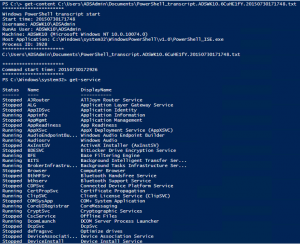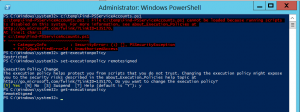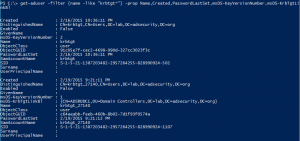PowerShell version 5 is RTM (As of 12/18/2015). Prior to this there was a “production preview” available since August which means it was supported, but not final. With the final release of PowerShell v5 now available, I highly recommend you download PowerShell v5 and start testing to prepare for production deployment. While the PowerShell v5 …
Category: PowerShell
Jan 07 2015
PowerShell Security: Execution Policy is Not An Effective Security Strategy – How to Bypass the PowerShell Execution Policy
If you have worked with PowerShell recently, you may have run into an Execution Policy message: c:\temp\Find-PSServiceAccounts.ps1 : File C:\temp\Find-PSServiceAccounts.ps1 cannot be loaded because running scripts is disabled on this system. For more information, see about_Execution_Policies at http://go.microsoft.com/fwlink/?LinkID=135170. At line:1 char:1 + c:\temp\Find-PSServiceAccounts.ps1 + ~~~~~~~~~~~~~~~~~~~~~~~~~~~~~~~~~~ + CategoryInfo : SecurityError: (:) [], PSSecurityException + FullyQualifiedErrorId : …
Dec 05 2014
Windows Computer Primary Group IDs
Primary Group IDs are the RIDs for the Domain groups. The full list is here: Interesting Windows Computer & Active Directory Well-Known Security Identifiers (SIDs). 515 – Domain Computers 516 – Domain Controllers (writable) 521 – Domain Controllers (Read-Only) This information helps filter computer objects to return only the desired computer type. Domain Computers (Workstation …
Nov 17 2014
PowerShell: Discover Active Directory Forest Domain Controllers
Recently I needed to find all Domain Controllers in a large Active Directory forest (and see the AD Domain Functional Level for each domain). Here’s the PowerShell code which leverages the Active Directory PowerShell module cmdlets. import-module ActiveDirectory $ADForestInfo = Get-ADForest $ADForestInfoName = $ADForestInfo.Name $ADForestInfoDomains = $ADForestInfo.Domains $ADForestInfoForestMode = $ADForestInfo.ForestMode $AllDCs = $Null ForEach …
Nov 17 2014
PowerShell Encoding & Decoding (Base64)
PowerShell provides an easy method for Base64 encoding and decoding. Encoding: $Text = ‘This is a secret and should be hidden’ $Bytes = [System.Text.Encoding]::Unicode.GetBytes($Text) $EncodedText =[Convert]::ToBase64String($Bytes) $EncodedText The result is this base64 encoded text: VABoAGkAcwAgAGkAcwAgAGEAIABzAGUAYwByAGUAdAAgAGEAbgBkACAAcwBoAG8AdQBsAGQAIABiAGUAIABoAGkAZABlAG4A Decoding: Decoding the base64 encoded blob using PowerShell is simple. $EncodedText = “VABoAGkAcwAgAGkAcwAgAGEAIABzAGUAYwByAGUAdAAgAGEAbgBkACAAcwBoAG8AdQBsAGQAIABiAGUAIABoAGkAZABlAG4A” $DecodedText = [System.Text.Encoding]::Unicode.GetString([System.Convert]::FromBase64String($EncodedText)) $DecodedText
Nov 16 2014
PowerShell: Find All Users in Active Directory the Optimal Way
Today I Learned (TIL) that the best way to find all users in Active Directory via LDAP query is to search for: (samAccountType=805306368) and NOT: (&(objectClass=user)(objectCategory=person)) Reference: http://www.selfadsi.org/extended-ad/search-user-accounts.htm
Nov 16 2014
PowerShell 101: Easy Script Timing
There are times when you want to know how long it takes for a script to run. One of the Measure-* cmdlets can be useful, but there is a simpler way to time how long it takes to run a script (or piece of code). The StopWatch .NET method is an ideal method for script …
Nov 15 2014
Owning Networks and Evading Incident Response with PowerShell
PowerShell provides an easy method to bypass antivirus and other protection methods: Up until several months ago, I was a member of a penetration test team tasked with compromising data centers and evading detection. Industry standard tools such as Metasploit (an attack toolkit that includes a backdoor named Meterpreter) and Mimikatz (a password dumper) …
Nov 10 2014
Kerberos & KRBTGT: Active Directory’s Domain Kerberos Service Account
Every Domain Controller in an Active Directory domain runs a KDC (Kerberos Distribution Center) service which handles all Kerberos ticket requests. AD uses the KRBTGT account in the AD domain for Kerberos tickets. The KRBTGT account is one that has been lurking in your Active Directory environment since it was first stood up. Each Active …
Nov 09 2014
PowerShell Code: Check KRBTGT Domain Kerberos Account Last Password Change
From my GitHub Repo: Get-PSADForestKRBTGTInfo This function discovers all of the KRBTGT accounts in the forest using ADSI and returns the account info, specifically the last password change. Currently, the script performs the following actions: * Queries a Global Catalog in the Active Directory root domain for all KRBTGT accounts in the forest by querying …




Recent Comments